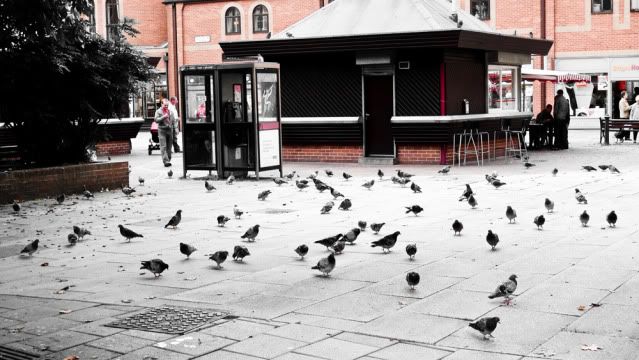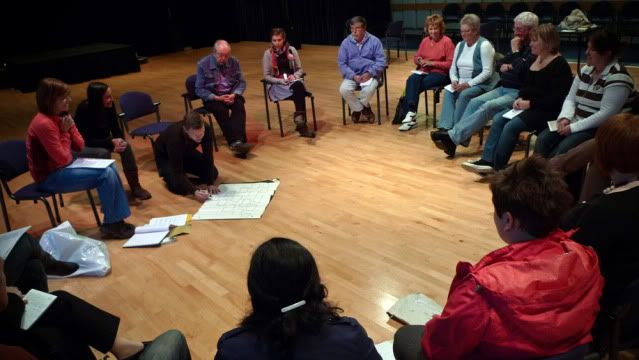
All images © Christian Payne.
Over the summer I have been working with Theatre Writing Partnership as a freelance online communications officer, looking at social media and other possible approaches to the digital world/s in their work.
TWP have a really special place in my heart, they were the first company who ever took an interest in my writing, and way back in 2005 gave me my first ever production. Because of that I have really relished the opportunity to give back to them by helping them cultivate a digital footprint and focus their new digital angle to coincide with the company’s re-launch. They have been wonderfully receptive to all my over-enthusiastic tech-rants, and my work with them culminated this weekend, with the two day City Adventure/City Staged event. So I thought I’d just take a few minutes to throw down some reflections and some of the gorgeous documentation that came out of the project.
What was it all?
The first day was a city-wide adventure – a kind of treasure-hunt with clues and tasks that produced images, sounds and creative writing in the morning, and then a coming together of participants to produce scripts and monologues in the afternoon. The second day brought a director and 4 actors to the material, producing a performance and presentation that evening: A City Staged.
Here’s Documentally talking to Kate Chapman about the first day: A City Adventure.
A City Adventure/Staged was born out of Stan’s Cafe’s idea of ‘risk days’. Basically TWP and SC got together and set out on the two day project, knowing very little about the content of the finished product. Likewise participants showed up on the day, never having met their partners, and having received mysterious, not-to-be-opened envelopes. It was a bold and unusual experiment in theatre writing which was really exciting to be a part of.
On the first day I was working alongside the excellent Christian Payne (Documentally), not amplifying the event as two observers, but traversing the adventure in exactly the same way as the rest of the participants, (only grabbing audio, video, text and images along the way too). This, I think, is a really good example of how theatre can use social media, we weren’t amplifying an event, as much as we were amplifying the experience, something that seemed to garner a decent reaction from the twittersphere.
Here’s a quick taste of video turning points in the Adventure…
There was something in recording the experience, too, that the participants really seemed to latch on to, I got many of them asking for where all the material would be posted. There was a wholeness of experience involved in the work – they walked it, they wrote it, and then they watched others bring life to what they’d written, all within the space of 48 hours – they weren’t a traditional audience any more, and in a small way the digital content seemed to allow them an opportunity to reflect on their experiences, and to hold on to them a bit longer.
Here we have Documentally interviewing several of them, just back from the morning’s adventure.

As a half formed thought/aside: although IRL the trad audience didn’t exist any more –you could argue that the people following and engaging with the online content, watching characters, framed, performing a found narrative – you could argue that they were performing the trad audience role, just in a media-snacking style format.
The material that the City Adventure participants produced was on the Saturday wrought into shape by TWP’s Artistic Director Kate Chapman, and a team of four actors. Here’s a couple of short interviews with actors Gary and Rochi, just before and after the performance, talking a little about the process involved, and how it felt to meld the material into shape:
There was a real sense that structuring the piece – something you might think to be a problem with 18 different writers involved – was surprisingly simple, and in fact that what emerged was place – site – the city of Derby breathed through it all, leading a way. In the same way, the ability to geo-tag (particularly) the digital media we took meant that our journey, too, was scored through the city. There’s something really fascinating there about site-specific work with a digital arm (echoed in the Playwriting for the iPod Generation workshop, which focussed on digital storytelling tied to actual space, more later!) which I think is going to bear a lot more investigation from me as I begin to launch into my PhD…
The final City Staged presentation took the form of a collection of images and sounds recorded throughout the day, and a staged reading of the theatre-writing. Here’s a quick four minute excerpt from the piece I took with my iPhone, it catches the move between a collage of image and sound into the performance of the writing:
There are loads more images, video and audio on TWP’s Posterous. The audioboos recorded throughout the two days are the best way to follow the tasks and process in detail, (the form of geo-tagged audio, complete with picture, turned out to be the best way of tracking such a location-specific event) you can find them under the tag cityadventure (I could embed a playlist, but there’s probably enough embed-loveage going on here already)
You can also find the audioboos mapped, and listen to them without leaving the map view, here. (Massive thanks to code-ninja @buddhamagnet for the mapping facility – something which I think is the most exciting piece of content from the day, if only we could have geo-tagged/mapped all of our content! [another thing to work on])
I think I’ll finish an interview with Jayne, one of the City Adventure participants reflecting on the feeling of seeing her writing staged, and a slideshow of some of the images taken by Documentally . It really was a extraordinary couple of days, massive thanks to Documentally for all his hard work, and congrats to the TWP team, for a wonderful launch to their new programme.
PhD starts properly tomorrow! Can’t wait to get my hand on some big ideas… books ho!